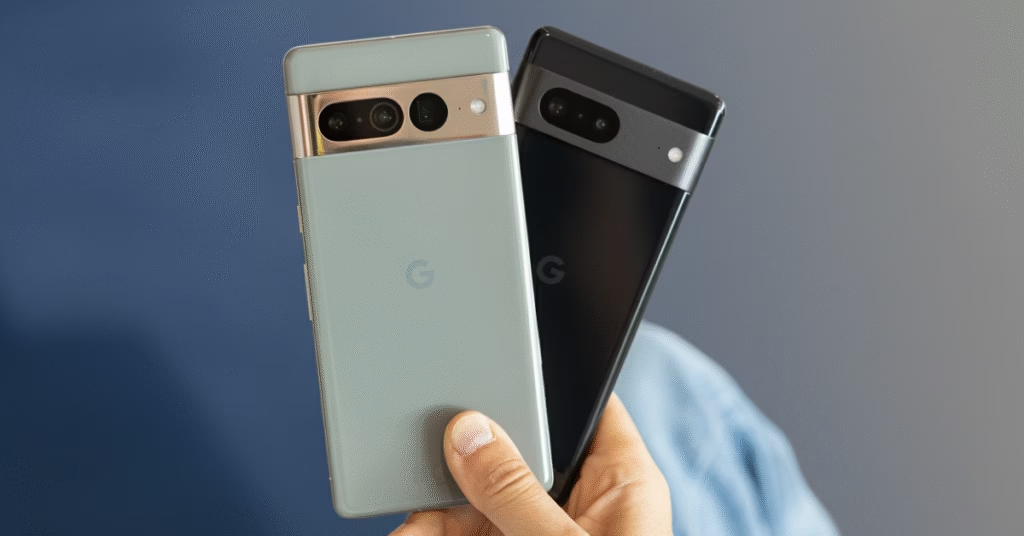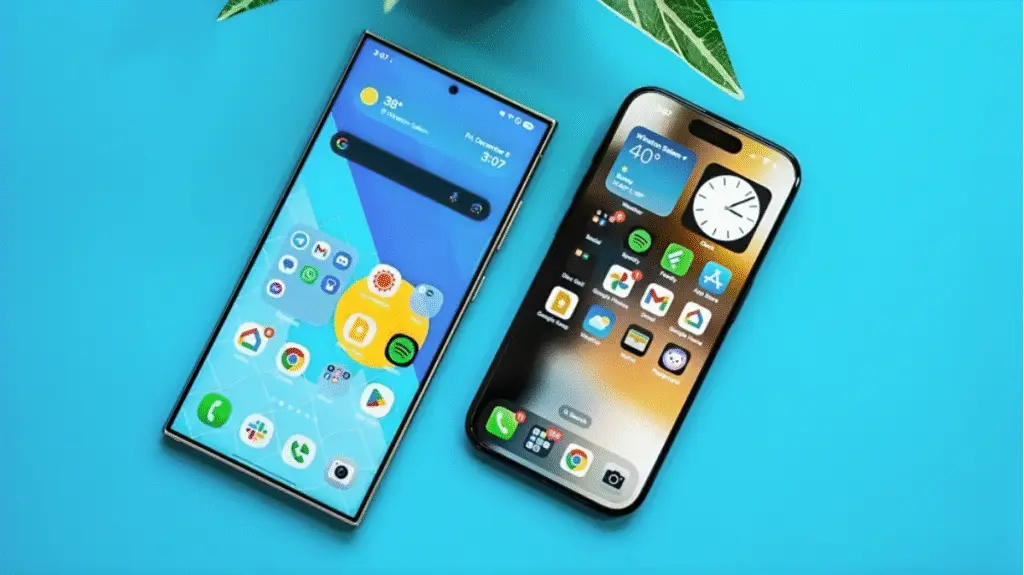
When I first picked up the Google Pixel 7 Pro in late 2022, it felt like one of the most polished phones I’d ever used. It had that large, vibrant screen, a versatile camera setup, and the kind of premium build that made you feel you were holding something special. Fast forward a year, I found myself with the Pixel 8, the new generation that Google introduced in 2023. At first, I wondered: would this phone really feel like an upgrade, or was it just another incremental step? After using both as my daily drivers, I can share what the experience is truly like.
First Impressions
The Pixel 7 Pro immediately struck me with its size and elegance. A 6.7-inch curved-edge display, slim bezels, and a soft glass finish gave it a premium edge. It felt like a phone designed for people who want more than the basics.
The Pixel 8, on the other hand, goes in a slightly different direction. Its 6.2-inch display makes it noticeably smaller and easier to handle with one hand. The design feels a bit more compact, but it still keeps the familiar Pixel look with the camera bar across the back. For someone who finds the 7 Pro a little too big, the Pixel 8 feels refreshing.
Quick Comparison
| Specification | Pixel 7 Pro | Pixel 8 |
|---|---|---|
| Display | 6.7″ LTPO OLED, QHD+, 120Hz | 6.2″ OLED, FHD+, 120Hz, brighter |
| Chipset | Tensor G2 | Tensor G3 (more efficient) |
| RAM | 12GB | 8GB |
| Main Camera | 50MP + 12MP ultra-wide + 48MP telephoto (5x) | 50MP + 12MP ultra-wide |
| Front Camera | 10.8MP | 10.5MP |
| Battery | 5,000mAh, 30W charging | 4,575mAh, 30W charging |
| Software Support | 5 years (until 2027) | 7 years (until 2030) |
| Build | Aluminum frame, curved glass back | Aluminum frame, flat glass back |
| Connectivity | Wi-Fi 6E, Bluetooth 5.2 | Wi-Fi 6E, Bluetooth 5.3 |
| Weight | 212g | 187g |
| Launch Price | $899 | $699 |
Disclaimer: Specs and prices may vary by region. Always confirm with official sources.
Performance in Real Life
Performance is where I began noticing differences almost immediately. The Pixel 7 Pro runs on Google’s Tensor G2 chip paired with 12 GB of RAM. It’s smooth for everyday use browsing, messaging, streaming but when I pushed it with heavier tasks like video editing or long gaming sessions, it started to show a bit of lag and heat. It never failed me, but I could feel the limits.
The Pixel 8 introduces the Tensor G3 chip, and it feels more efficient. Even though it comes with only 8 GB of RAM, it handles multitasking with ease. Switching between apps, editing photos, and streaming in the background all feel snappier. More importantly, it doesn’t heat up as quickly as the 7 Pro. The chip isn’t just about speed it’s also about efficiency, and I noticed it most when juggling several tasks at once.
Display Experience
The Pixel 7 Pro’s display is one of the best I’ve used. That LTPO OLED panel at QHD+ resolution delivers stunning sharpness. The 120 Hz refresh rate makes every scroll feel buttery smooth. Watching videos or playing games on this big screen feels immersive; it’s almost like having a small tablet in your pocket.
Switching to the Pixel 8, I admit the smaller display initially felt like a downgrade. At 6.2 inches and 1080p resolution, it isn’t as sharp, and if you love big screens, you’ll miss the 7 Pro. But there’s a trade-off. The Pixel 8 is brighter, and its compact screen is easier to use outdoors in direct sunlight. Watching HDR content also pops more thanks to Google’s improvements in brightness. It’s a more practical screen for daily use, though not as cinematic as the 7 Pro’s.
Cameras
Here’s where the debate gets interesting. The Pixel 7 Pro carries a triple camera setup: 50 MP main, 12 MP ultrawide, and a 48 MP telephoto with 5x optical zoom. For me, this was a dream camera. I could take wide city shots, detailed zoomed photos, and portraits that looked professional. The zoom lens especially stood out, letting me capture moments from far away without losing detail.
The Pixel 8, however, takes a different approach. It drops the telephoto and sticks to a dual setup: 50 MP main and 12 MP ultrawide. At first, I thought this would be a huge step backward. But Google’s software magic really shines here. Thanks to the Tensor G3 and AI improvements, the Pixel 8 delivers sharper low-light shots, more accurate skin tones, and smoother night portraits. While I miss the telephoto zoom, the overall image quality in everyday scenarios often looks better on the Pixel 8, especially in tricky lighting.
If you’re into zoom photography, the 7 Pro still has the edge. But for most casual users, the Pixel 8’s software-enhanced results are more consistent and practical.
Battery Life and Charging
The Pixel 7 Pro houses a 5,000 mAh battery, which sounds great on paper. In reality, though, I often found myself charging it before the day ended if I was using it heavily. Streaming, navigation, and camera use drained it quickly.
The Pixel 8, with its smaller 4,575 mAh battery, shouldn’t perform better but it does. Thanks to the efficiency of the Tensor G3 chip, I was ending my days with 20–25% left even after long hours of use. It may not be the biggest battery, but it’s optimized well. For charging, both phones deliver similar speeds, though I found the Pixel 8 slightly more consistent in topping up quickly when I needed it.
Software and Longevity
Both phones run on Google’s clean version of Android, but the Pixel 8 has a major advantage here. Google promises seven years of software and security updates for the Pixel 8. That’s unheard of in the Android world and gives the Pixel 8 a huge edge in long-term value.
The Pixel 7 Pro will still get updates, but it won’t be supported nearly as long. If you plan to keep a phone for more than a few years, the Pixel 8 is the clear winner.
The other key difference lies in AI features. The Pixel 8 comes with exclusive tools like enhanced photo editing, better voice-to-text, and even smarter assistant features. The 7 Pro still performs well, but you’ll feel a bit left out as these AI tools are heavily marketed and very practical.
Connectivity and Extras
The Pixel 7 Pro, being a Pro model, came with all the bells and whistles of its time: 5G, Wi-Fi 6E, and Bluetooth 5.2. It still feels modern and well-equipped.
The Pixel 8 steps it up slightly with Wi-Fi 6E and Bluetooth 5.3, making connections faster and more stable. In practice, I noticed quicker file transfers and smoother audio connections with wireless earbuds. It’s not a game-changer, but it’s a nice upgrade.
Living With Both
Using the Pixel 7 Pro felt like driving a luxury SUV powerful, spacious, and capable of handling anything. The Pixel 8, on the other hand, feels like a smart compact car nimble, efficient, and perfectly suited for everyday life.
The 7 Pro’s large screen, telephoto camera, and big battery appeal to power users who want a phone that does it all. The Pixel 8, however, balances performance, size, and longevity in a way that feels more practical for the average person.
Final Verdict
After spending time with both phones, I can say the google pixel 7 pro vs 8 comparison isn’t just about specs. It’s about what kind of user you are.
- If you love big displays, need telephoto zoom, and don’t mind a phone that’s slightly bulkier, the Pixel 7 Pro still feels like a powerhouse.
- If you prefer a more compact design, want longer software support, and care about the latest AI-driven features, the Pixel 8 is the better choice.
For me, the Pixel 8 ended up being the phone I reached for more often. It’s simply easier to carry, lasts longer on a charge, and feels more future-proof. But I still have a soft spot for the Pixel 7 Pro, especially when I need that zoom camera for capturing distant moments.
In the end, both are excellent devices, but the right choice depends on whether you value size and camera versatility or compact design and future software support.
See Also Pixel 8a vs 9a: The Mid-Range Battle Explained
FAQs
Does the Pixel 8 have a telephoto camera like the Pixel 7 Pro?
No, the Pixel 8 only has a dual camera setup (main + ultrawide). The Pixel 7 Pro includes a telephoto lens with 5x optical zoom.
Which has better battery life, Pixel 7 Pro or Pixel 8?
Despite having a smaller battery (4,575 mAh), the Pixel 8 offers better endurance thanks to the efficiency of the Tensor G3 chip. The Pixel 7 Pro (5,000 mAh) drains faster with heavy use.
How long will Google support these phones with updates?
The Pixel 8 gets seven years of OS and security updates, making it one of the longest-supported Android phones. The Pixel 7 Pro will receive updates for around three more years.
Is the Pixel 7 Pro still worth buying in 2025?
Yes, if you value a bigger display and telephoto zoom, the Pixel 7 Pro remains a strong option. However, for longevity and AI features, the Pixel 8 is the smarter choice.
Which phone is more compact and easy to handle?
The Pixel 8, with its 6.2-inch screen, is smaller and more comfortable for one-handed use compared to the larger 6.7-inch Pixel 7 Pro.
